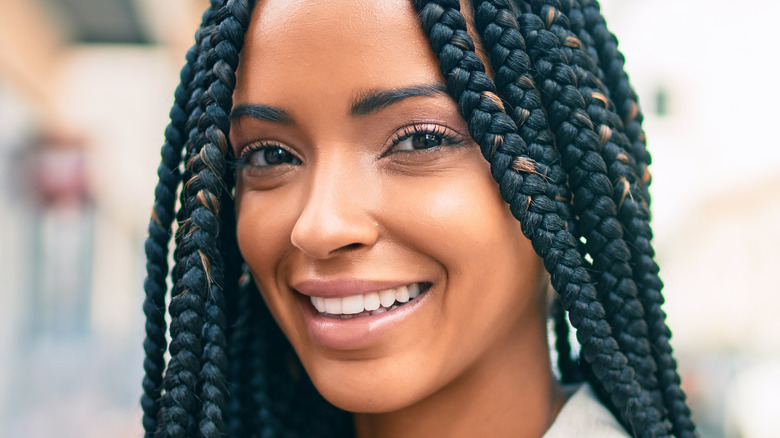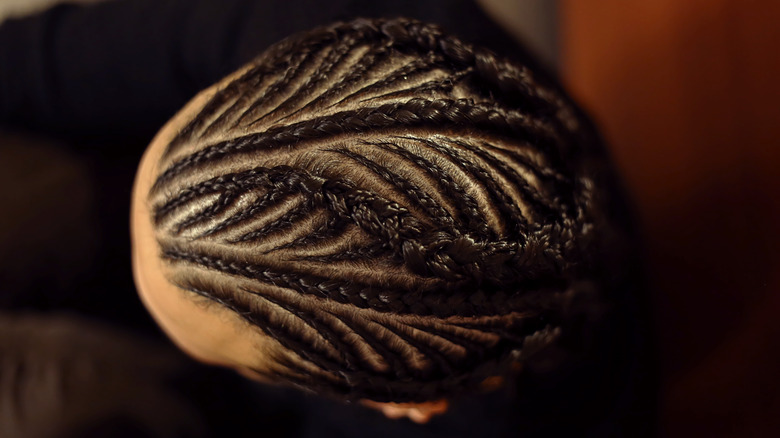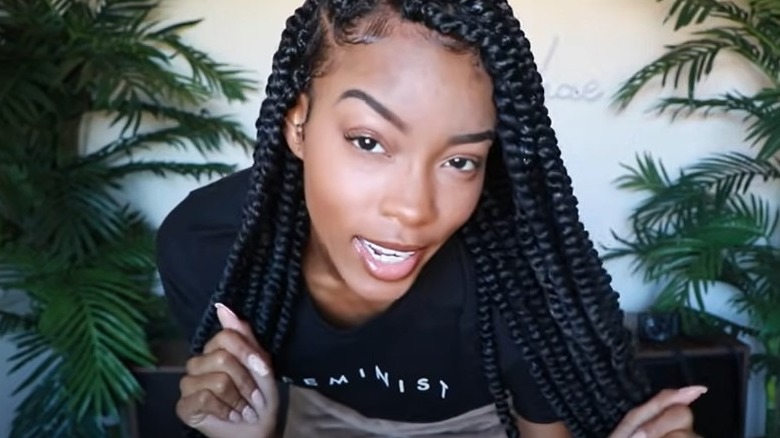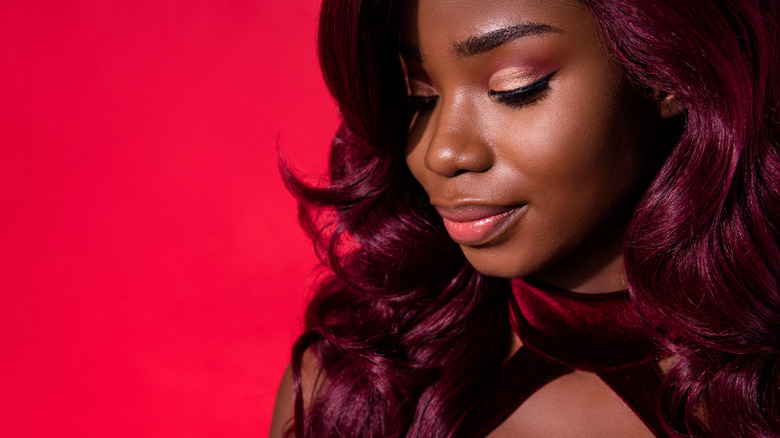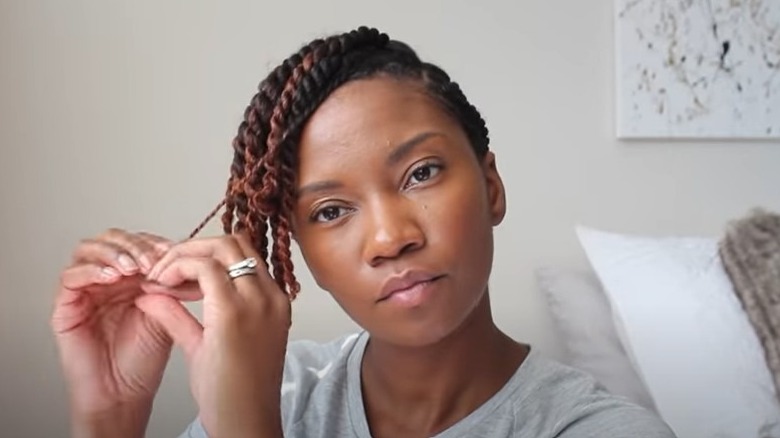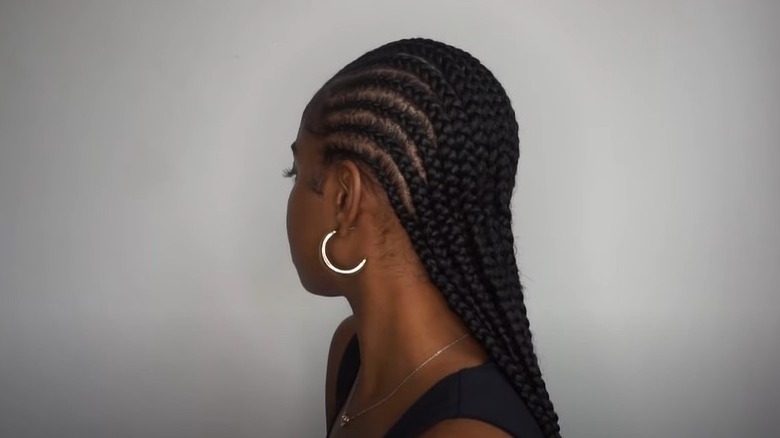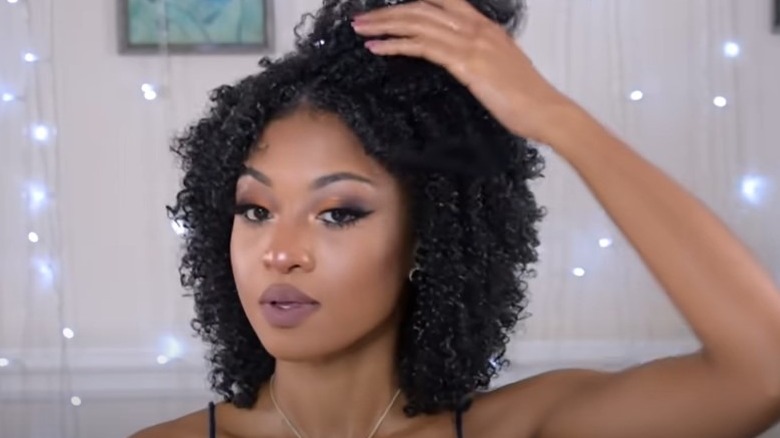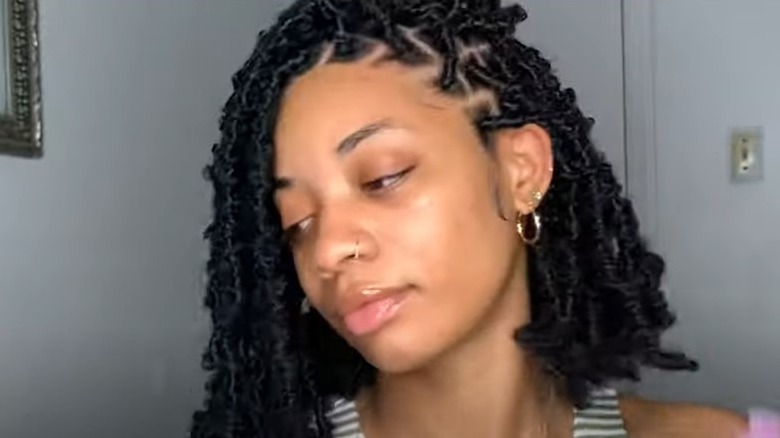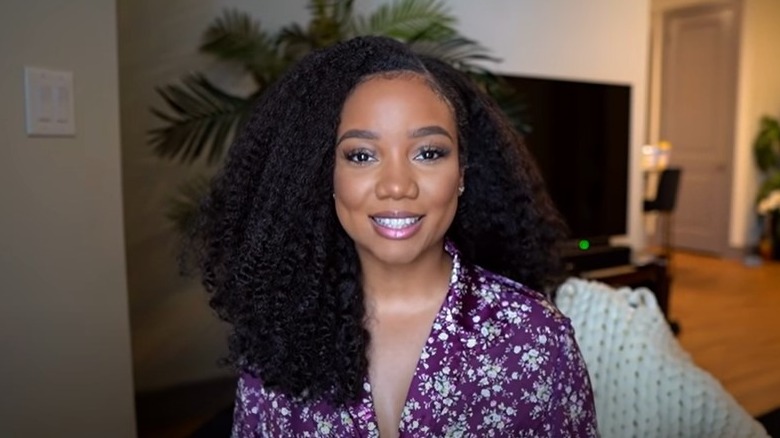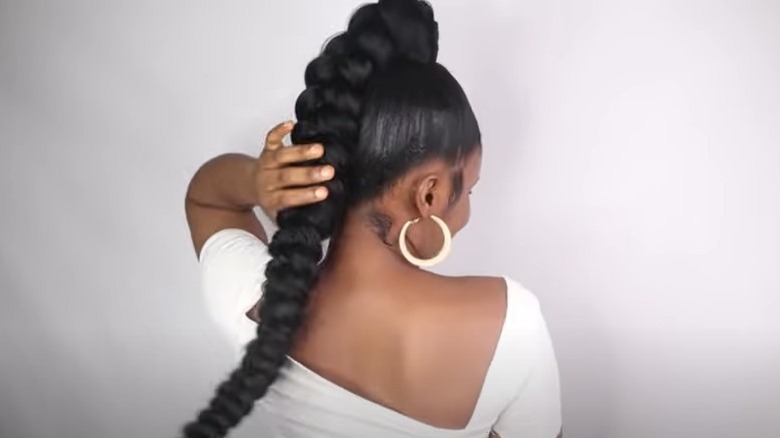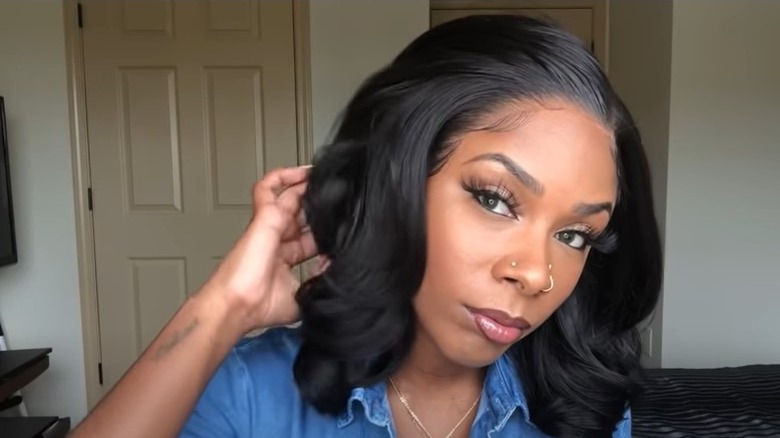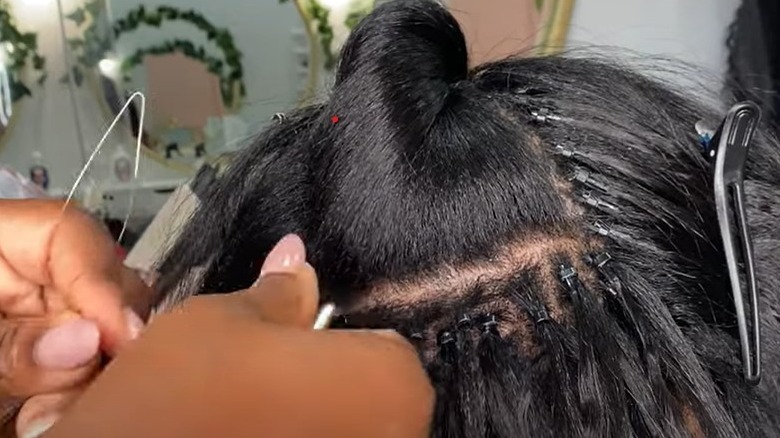Here's What You Should Know Before Getting A Protective Hairstyle
Here's a reality about hair that is always important to keep in mind. Unless you're someone who has some sort of health-related issue that makes it difficult for your hair to grow (like alopecia, for example) or your hair follicles have encountered some level of trauma that has resulted in them not being able to produce hair strands (such as overprocessing your hair with chemicals), your hair is always growing. The reason why it might seem like some people's hair is growing faster or longer than others boils down to two main things: genetics and hair texture. Overall, everyone's hair grows about 1/2 inches a month, and your hair texture (which basically determines the level of curl your hair strands have) influences how long your natural hair appears to be.
When it comes to Black women specifically, oftentimes they have a curlier texture which can make it appear as if their hair is shorter than it actually is (until they straighten it out). Plus, the natural sebum that we all produce in order to keep our hair healthy can have a hard time getting all the way down curly hair; as a result, hair can become dry and brittle. So, what can be done if length retention for a Black woman is the ultimate hair goal? Protective styling. It's one of the best ways for Black women to get and maintain the long and healthy hair they may be looking for.
What exactly is a protective style?
When you think of something being protected, what comes to your mind? Probably anything that guards a person or thing from being injured. Well, when it comes to protecting hair strands, that is exactly what a protective style is — it's a literal hairstyle that specifically serves the purpose of protecting the shaft and ends of one's hair (via Harper's Bazaar).
The great thing about protective styles is, once one is in place, it will significantly reduce the amount of manipulation that hair tends to experience from styling tools like combs, brushes, blow dryers, and flat irons. And the less that hair is touched, the more freedom it has to flourish. That's why it's pretty common for women who have had their hair in a protective style for six to eight weeks to notice that their hair is both longer and healthier once they take the hairstyle down. Hands down, protective hairstyles are the answer to flourishing tresses. With the definition established, let's get into some other important things that you should know.
What you can do to make a protective style benefit you the most
Now that you know the purpose that protective hairstyles serve, you might be interested in getting one as soon as possible. Before you do, there are a few things to keep in mind, just so you can get the most out of having this kind of look. First, as noted by Naturally Curly, be open to getting your protective style professionally done. Whether it's braids, twists, or even a weave (which we'll get more into in just a moment), you want to make sure that your hairstyle is installed correctly, so that your natural hair isn't damaged in the process.
Next, try and focus on washing your scalp more than your hair while you have a protective hairstyle. The reason why is shampooing your hair like you usually do can result in a lot of frizz or it could even loosen the style, which shortens the longevity of it.
And finally, wrap your protective style up at night. Friction can create a bit of a mess, and you're sure to cause that to your hair whenever you're rolling around in your sleep. By tying your protective hairstyle up with a silk or satin scarf or a hair bonnet, you will help the style last longer.
Mistakes that people make while wearing a protective style
Now that you know a few ways to properly maintain your protective hairstyle, it's important to get into some of the mistakes that people may make when they have this kind of look in their hair.
A big one is going past the "shelf life" of a protective style. For instance, box braids shouldn't be in your hair for any longer than six to eight weeks (via BuzzFeed), while two-strand twists should only last for two to four weeks, depending on their size. Going beyond that could result in your hair "locking up" (like dreadlocks), which can make it difficult to take your protective hairstyle down without damaging your hair in the process.
Another mistake is not properly moisturizing your natural hair if you're using extensions before and while your protective style is in, according to Self. Just because your natural hair is more covered up, that doesn't mean that your hair and scalp do not need some level of hydration. Using a water bottle that has a carrier oil in it — like grapeseed, avocado, argan, or sweet almond oil (via Byrdie) — to lightly spray your hair a couple of times a day can soothe your scalp and condition your hair without leaving any residue on the hairstyle itself.
Now that we've touched on some ways to preserve your protective hairstyle, let's get into some different looks.
There are many different braided styles to choose from
One of the best things about getting your hair done in braids is there are a ton of different looks that you can go with (via Marie Claire). You can get box braids. You can get microbraids. Lemonade braids are super cute. Feed-in braids are a popular option as well. And because you can totally choose the style and length, you can easily just get up and go every day without having to do much to your hair at all for weeks on end.
The main thing to keep in mind with braids is your hair needs to be super-conditioned prior to installing them. Speaking of conditioning, according to Kendall Dorsey, a celebrity stylist who spoke with PureWow, applying a leave-in conditioner to your braids after they are installed and then applying a serum to them as well can help to keep hair dryness at bay while also preventing flyaways (strands of hair that creeps out from your braids). And you definitely should give your hair a break for a couple weeks in between getting a new set; that's because braids can sometimes cause a certain amount of weight and tension on your hair — the kind that could result in hair breakage or even hair loss, if you're not careful.
Twists are a great option for people who don't have patience for braids
The main difference between a braid and a twist is, traditionally, a braid consists of intertwining three pieces of hair while a twist incorporates two. Some examples of hair twists are finger twists, flat twists, Senegalese twists, Marley twists, and Marley twists. While they're simply a different type of look, one of the major pluses about going with twists over braids is the takedown time that you can oftentimes cut in half because all you have to do is take the bottom of each twist down and unravel.
If you're looking for a DIY approach to protective hairstyles, Vernon Francois, a hairstylist for Academy-award winner actor Lupita Nyong'o, told Elle, "Two-strand twists are very simple and work for all hair textures, kinky, coily, curly or wavy." It's a very pretty protective hairstyle option that you can get installed in half the time of braids too. Perfect!
You can create beautiful designs with cornrows
A favorite protective hairstyle for women of all ages is cornrows. These consist of hair that is sectioned off and then braided in a way that causes them to lie flat on your scalp. A part of what makes cornrows visually mesmerizing is that the way the hair is parted can create all kinds of stunning designs and patterns — and they look just as beautiful whether you use extensions or not.
Gail Waterman, cofounder of Watermans Hair, told PopSugar, "Cornrows are adored as it's a low-maintenance and great protective style — it helps protect your hair from moisture loss and breakage — but you have to upkeep a routine." A specific thing to keep in mind as far as cornrows go is, since so much of your scalp is showing, it's a good idea to exfoliate your scalp to remove dead skin cells prior to braiding your hair and to spray your scalp with some hair sheen to keep it moisturized once the braids are in.
Wash-and-gos are super low maintenance
While on the surface, a wash-and-go may not be considered to be a protective hairstyle, it absolutely should be. Remember that protective styles are all about styling your hair in a way that requires as little manipulation and upkeep as possible. To achieve a wash-and-go, you just need to wash and deep condition your hair, as noted by Beauty Magazine. Then apply a leave-in conditioner and some sort of styling gel or mousse, so that your natural hair texture shines through and you don't have to do too much more to it after styling and allowing your tresses to air dry.
"One of the best benefits to wash-and-go styling is that you're simply incorporating your entire hair-care and styling routine into your shower routine," Anthony Dickey, the co-founder of salon and hair-care line Hair Rules, told Elle. If you're looking for a protective style that is cheap, quick, and super low-maintenance, a wash-and-go is the way to go.
You'll probably want to visit a salon for faux locs
Another wonderful thing about protective styles is they can help you to achieve looks that you've always wanted without you having to make a long-term commitment to them. A great example of this is faux locs, which provide the appearance of dreadlocks without you having to marry yourself to them. Something else that's pretty awesome about this hairstyle is you can crochet them or you can wrap some synthetic hair around a braided piece of hair in order to achieve the overall look.
When "resident Cosmopolitan braider" Stasha Harris was asked for some tips on how to get the absolute most out of faux locs, one of the things that she recommended was going to a reputable stylist because you want to make sure that the locs aren't so heavy that they end up weighing your natural hair down and causing breakage or hair loss as a direct result of it. That's really good advice.
You can try crocheting at home with the help of YouTube videos
The sheer ingenuity of some of these protective hairstyles is amazing on a myriad of levels. Take crocheting, for instance. It's a technique that's all about using a latch that's designed for hair to "hook" a piece of hair onto a braid that is already on your scalp — in a way that is much like crocheting.
So, how effective is it? Believe it or not, the feature picture for this particular section is the end result of crocheting (you can watch how she did it here). One of the reasons why this protective hairstyle is so popular is that a lot of people have learned how to do it from the comfort of their own home thanks to all of the step-by-step instructional videos on platforms such as YouTube, which is obvious super convenient and helps save on money. And because the styling options are endless, it's definitely a look to at least consider giving a shot.
Latched And Hooked CEO Tiffini Gatlin said to Byrdie in an interview that a major perk about crocheting is it's "breathable while leaving your scalp accessible for easy cleaning." Having a style that keeps your hands out of your hair while letting you still care for your scalp is the perfect combo when it comes to achieving healthy hair.
Ponytails with extensions are a good option
If it surprises you to see ponytails on a list of protective hairstyles, there's a specific reason why they made the cut. Since a big point of having a protective hairstyle is to protect your ends, unless you decide to turn a ponytail that's made from natural hair into a bun, a natural ponytail doesn't really check off this box. However, if you opt to have an extension added to your ponytail — and you decide to get your ponytail professionally done — it can absolutely serve as a protective hairstyle because your natural hair will be tucked away. Ponytails with extensions can easily last for two to three weeks, so long as you tie them up at night.
"The ponytail is easy to maintain ... You can use care products that you use on your own hair to take care of your ponytail, especially if it's in your texture," founder and CEO of Heat Free Hair Ngozi Opara told Bustle.
Also, a bonus that comes with ponytails is while they are fairly low-maintenance, you can easily dress them up — or down.
You can opt for a wig, but be sure to care for it
It's a pretty safe bet to say that there have probably been times when you have seen someone with a wig on but didn't know that it actually was one. There are even celebs you'd be surprised to know wear wigs! That's how far wigs have come; especially when it comes to some of the lace fronts that are currently on the market. And yes, wigs are considered to be a protective style because if you wash, condition, and braid your hair down and then put on a wig cap and a wig, your natural hair is protected from harsh weather elements; there's no need for you to style it either.
Some other awesome things about wigs is they provide a lot of versatility, they're super convenient, and, so long as you take really good care of them, they can easily last you a couple of years. Hairstylist Ursula Stephen shared a great hack to make your wig look its best when speaking with Refinery29. "A lot of wigs — especially synthetic ones — can be extremely shiny, which causes the hair to look unnatural," she said. "Using dry shampoo is an amazing way to sop up some of that shine and make the strands look more real."
Weaves can last up to eight weeks
Weaves are another protective style that mixes your natural hair with extensions by sewing, gluing, or clipping your hair to them. If your hair is cornrowed and then some extensions are attached, that gives your hair a break from daily styling. Hair + Space lead stylist and weave specialist, Sadetra Windham told Harper's Bazaar, "Weave styles are limitless. You can have so much fun with color, cuts, and styles without actually doing anything damaging to your real hair." So true. Plus, a good weave can last between six to eight weeks at a time (via Cosmopolitan).
The picture above shows what happens when you get a particular kind of weave that is known as microlinking. It's when a small section of hair is pulled through a microbead, and then a section of hair extension is also pulled through and the bead is closed to secure the hair, as explained by Naturally Curly. A lot of people like this weave technique because it lies very flat on your head (so that it looks very realistic), it blends in almost seamlessly, and it's a great option if you want to wear high ponytails a lot. Just one more protective hairstyle option to consider, especially if you exercise a lot or plan on going on vacation soon. It's a fan favorite as far as protective hairstyles go, no doubt.
